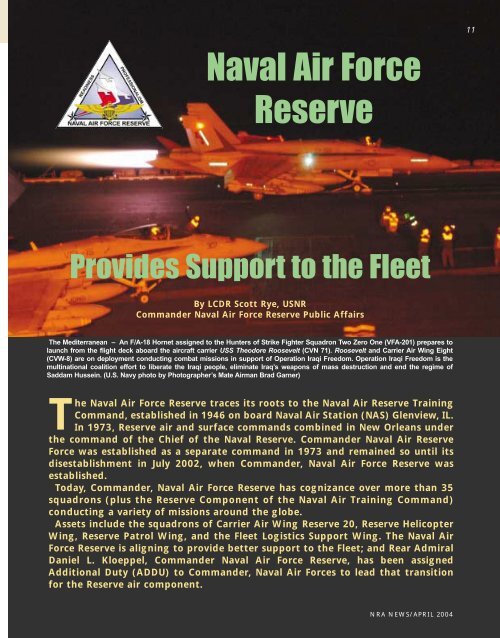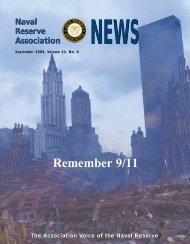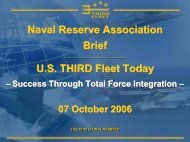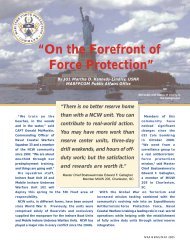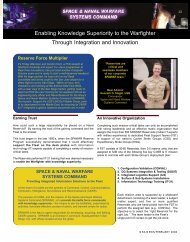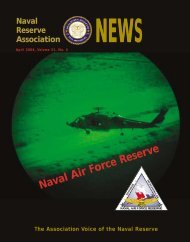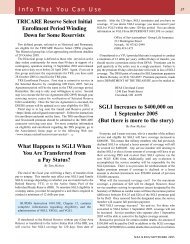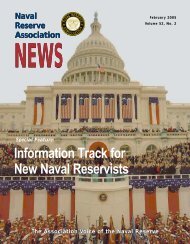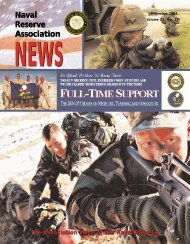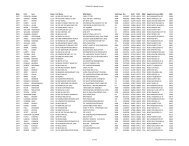Naval Air Force Reserve
Naval Air Force Reserve
Naval Air Force Reserve
Create successful ePaper yourself
Turn your PDF publications into a flip-book with our unique Google optimized e-Paper software.
11<br />
<strong>Naval</strong> <strong>Air</strong> <strong>Force</strong><br />
<strong>Reserve</strong><br />
Provides Support to the Fleet<br />
By LCDR Scott Rye, USNR<br />
Commander <strong>Naval</strong> <strong>Air</strong> <strong>Force</strong> <strong>Reserve</strong> Public Affairs<br />
The Mediterranean – An F/A-18 Hornet assigned to the Hunters of Strike Fighter Squadron Two Zero One (VFA-201) prepares to<br />
launch from the flight deck aboard the aircraft carrier USS Theodore Roosevelt (CVN 71). Roosevelt and Carrier <strong>Air</strong> Wing Eight<br />
(CVW-8) are on deployment conducting combat missions in support of Operation Iraqi Freedom. Operation Iraqi Freedom is the<br />
multinational coalition effort to liberate the Iraqi people, eliminate Iraq’s weapons of mass destruction and end the regime of<br />
Saddam Hussein. (U.S. Navy photo by Photographer’s Mate <strong>Air</strong>man Brad Garner)<br />
The <strong>Naval</strong> <strong>Air</strong> <strong>Force</strong> <strong>Reserve</strong> traces its roots to the <strong>Naval</strong> <strong>Air</strong> <strong>Reserve</strong> Training<br />
Command, established in 1946 on board <strong>Naval</strong> <strong>Air</strong> Station (NAS) Glenview, IL.<br />
In 1973, <strong>Reserve</strong> air and surface commands combined in New Orleans under<br />
the command of the Chief of the <strong>Naval</strong> <strong>Reserve</strong>. Commander <strong>Naval</strong> <strong>Air</strong> <strong>Reserve</strong><br />
<strong>Force</strong> was established as a separate command in 1973 and remained so until its<br />
disestablishment in July 2002, when Commander, <strong>Naval</strong> <strong>Air</strong> <strong>Force</strong> <strong>Reserve</strong> was<br />
established.<br />
Today, Commander, <strong>Naval</strong> <strong>Air</strong> <strong>Force</strong> <strong>Reserve</strong> has cognizance over more than 35<br />
squadrons (plus the <strong>Reserve</strong> Component of the <strong>Naval</strong> <strong>Air</strong> Training Command)<br />
conducting a variety of missions around the globe.<br />
Assets include the squadrons of Carrier <strong>Air</strong> Wing <strong>Reserve</strong> 20, <strong>Reserve</strong> Helicopter<br />
Wing, <strong>Reserve</strong> Patrol Wing, and the Fleet Logistics Support Wing. The <strong>Naval</strong> <strong>Air</strong><br />
<strong>Force</strong> <strong>Reserve</strong> is aligning to provide better support to the Fleet; and Rear Admiral<br />
Daniel L. Kloeppel, Commander <strong>Naval</strong> <strong>Air</strong> <strong>Force</strong> <strong>Reserve</strong>, has been assigned<br />
Additional Duty (ADDU) to Commander, <strong>Naval</strong> <strong>Air</strong> <strong>Force</strong>s to lead that transition<br />
for the <strong>Reserve</strong> air component.<br />
NRA NEWS/APRIL 2004
12<br />
and counterdrug missions. The UH-3 Sea King,<br />
provides combat support and is capable of<br />
supporting firefighting missions. The wing is<br />
comprised of five squadrons, including its newest<br />
squadron, HSL-60, which was stood up in May<br />
2001.<br />
<strong>Reserve</strong> Patrol Wing<br />
At sea aboard USS THEODORE ROOSEVELT (CVN 71), a plane<br />
director guides a F/A-18 Hornet from the Hunters of Strike Fighter<br />
Squadron Two Zero One (VFA-201) into position on the ship’s<br />
flight deck. (U.S. Navy photo by Photographer's Mate 2nd Class<br />
James K. McNeil)<br />
Carrier <strong>Air</strong> Wing <strong>Reserve</strong> 20<br />
The <strong>Reserve</strong> Patrol Wing is the Navy’s largest<br />
patrol wing and includes seven squadrons flying<br />
the P-3C Orion, three Weapons System Trainer<br />
detachments and two Mobile Operations<br />
Command Centers. The wing’s squadrons are<br />
located in California, Florida, Louisiana, Maine,<br />
Pennsylvania, and Washington state. These patrol<br />
squadrons provide deterrence and counterdrug<br />
operations in the Caribbean and Pacific theaters<br />
and Fleet support around the world.<br />
Fleet Logistics Support Wing<br />
Carrier <strong>Air</strong> Wing <strong>Reserve</strong> 20 is the Navy’s only tactical <strong>Reserve</strong><br />
carrier air wing and includes three strike fighter squadrons<br />
(VFA), two fighter squadron composites (VFC), two carrier<br />
airborne early warning squadrons (VAW) and an electronic attack<br />
squadron (VAQ).<br />
The strike fighter squadrons fly the F/A-18 Hornet. One of<br />
these squadrons, VFA-201, was mobilized last year as part of<br />
Operation Iraqi Freedom (OIF). The F/A-18 is the Navy’s only<br />
tactical air platform designed for multiple missions. In addition<br />
to providing fleet air defense and force projection, the Hornet is<br />
also capable of deploying sea mines.<br />
Two other tactical air squadrons, VFC-12 and VFC-13, provide<br />
adversary training to the Fleet. VFC-12 is stationed on board NAS<br />
Oceana, VA, while VFC-13 is stationed on board NAS Fallon, NV.<br />
Carrier <strong>Air</strong> Wing <strong>Reserve</strong> 20 also provides electronic warfare<br />
capability through an EA-6 squadron, VAQ-209, and airborne<br />
early warning capabilities via its E-2C Hawkeye squadrons,<br />
VAW-77 and VAW-78. VAW-77 is the Navy’s only dedicated<br />
counterdrug squadron; and, like VFC-12 and VFC-13, VAW-77 is<br />
designated as a fleet support squadron.<br />
<strong>Reserve</strong> Helicopter Wing<br />
The first <strong>Naval</strong> <strong>Air</strong> <strong>Force</strong> <strong>Reserve</strong> squadron to deploy to Iraq<br />
for OIF was Helicopter Combat Support Special Squadron Five<br />
(HCS-5) Firehawks, which continues to provide combat search<br />
and rescue capabilities and special operations support. The<br />
Firehawks’ sister squadron, HCS-4, deployed to both the<br />
Mediterranean and North Arabian Gulf [along with HCS-5] to<br />
provide combat search and rescue support to the Fleet. While<br />
these two helicopter squadrons fly the HH-60 Sea Hawk, other<br />
<strong>Reserve</strong> helicopter squadrons fly the SH-60 Sea Hawk, conducting<br />
antisurface warfare missions, antisubmarine warfare missions,<br />
The Fleet Logistics Support Wing is comprised of 14 <strong>Naval</strong> <strong>Air</strong><br />
<strong>Force</strong> <strong>Reserve</strong> logistics squadrons that provide 100 percent of<br />
worldwide, intertheater medium and heavy airlift for the Fleet.<br />
These squadrons, their crews, and support personnel were critical<br />
to the coalition’s success in OIF and continue to play a vital role<br />
in global joint operations.<br />
A half dozen of the Navy’s newest logistics aircraft, the C-40A,<br />
have been accepted by <strong>Reserve</strong> squadrons. The C-40A replaces<br />
the aging fleet of C-9 Skytrains, a quarter of which are<br />
more than 25 years old. Fleet logistics squadrons also fly the<br />
venerable C-130 Hercules. Wing assets also provide support<br />
for senior Department of the Navy leadership, flying the C-20<br />
Gulfstream IV, the C-37 Gulfstream V and the C-12 King <strong>Air</strong>.<br />
Training Wings<br />
Chief of <strong>Naval</strong> <strong>Air</strong> Training headquarters is located onboard<br />
NAS Corpus Christi, TX, and oversees the <strong>Naval</strong> <strong>Air</strong> Training<br />
Command, which is composed of five Training <strong>Air</strong> Wings located<br />
on five <strong>Naval</strong> <strong>Air</strong> Stations in Florida, Mississippi, and Texas.<br />
These five wings are home to 16 training squadrons. The <strong>Reserve</strong><br />
Component of the wings includes squadron augment units<br />
(SAU). The training command has become a model for Active<br />
<strong>Reserve</strong> Integration (ARI), with the integration of nearly 270<br />
Drilling Reservists and 86 Full Time Support <strong>Naval</strong> aviators<br />
beginning in fiscal year 2003. Each of the 16 training squadrons<br />
were provided with a SAU under the operational control of the<br />
squadron commanding officer. The SAUs provide invaluable<br />
training support, not only to student pilots, but also, because of<br />
their years of experience, to many of the junior instructor pilots<br />
as well. The SAU construct also exists in Fleet Replacement<br />
Squadron (FRS) <strong>Air</strong> AntiSubmarine Squadron Four One (VS-41)<br />
with their <strong>Reserve</strong> SAU, the VS-0194 Moonlighters.<br />
NRA NEWS/APRIL 2004
13<br />
Load Master AD2 Thomas Schnieder of VR-54 checks the<br />
straps on his safety harness before opening the rear cargo bay<br />
door after take off. (Photo by Utilitiesman Third Class Ken Irwin,<br />
COMNAVRESFOR)<br />
Active <strong>Reserve</strong> Integration<br />
By CDR Jack Hanzlik<br />
<strong>Naval</strong> <strong>Reserve</strong> <strong>Force</strong> Public Affairs Officer<br />
Joint requirements continue pressing <strong>Naval</strong> assets around the<br />
globe, and our <strong>Naval</strong> <strong>Air</strong> <strong>Force</strong> <strong>Reserve</strong> team, “ready and fully<br />
integrated,” continues to demonstrate its relevance to our Navy<br />
and our nation’s warfighting wholeness.<br />
FY-03 clearly demonstrated the <strong>Naval</strong> <strong>Air</strong> <strong>Force</strong> <strong>Reserve</strong>’s<br />
ability to surge and sustain, to integrate seamlessly into the<br />
active-duty force for protracted operations, and to perform at the<br />
highest level of combat effectiveness. Hallmark performances<br />
like VFA-201’s mobilization and deployment with CVW Eight<br />
and the Theodore Roosevelt Battle Group; HCS-4 & 5’s ongoing<br />
support of CENTCOM Combat Search and Rescue (CSAR)<br />
operations; the VR community’s worldwide intertheater airlift<br />
(which accounts for 100 percent of the Navy’s capability); and the<br />
VAW/Maritime Patrol efforts in South America fighting the war<br />
on drugs are but a few examples of what makes our <strong>Naval</strong> <strong>Air</strong><br />
<strong>Force</strong> the most lethal, flexible force in the sky.<br />
FY-04 presents even greater opportunities to serve our nation,<br />
as force rotations and ongoing contingencies necessitate our<br />
continued presence forward and domestically. To meet these<br />
demands, our Navy continues to drive hard towards the one-Navy<br />
concept, integrating our Active and <strong>Reserve</strong> Components more<br />
tightly and aligning all efforts.<br />
This topic [Active <strong>Reserve</strong> Integration (ARI)] is one of the<br />
most prominent issues in our Navy today. ARI, in concert with<br />
global operations, also makes today one of the most exciting times<br />
in our history, as we have the opportunity to shape dramatically<br />
the future of our <strong>Naval</strong> <strong>Air</strong> <strong>Force</strong> <strong>Reserve</strong>.<br />
A comprehensive review of all <strong>Naval</strong> capabilities was directed<br />
by Commander, Fleet <strong>Force</strong>s Command (CFFC), Vice Admiral<br />
William Fallon, this past year to determine the Navy’s requirements<br />
for <strong>Reserve</strong> support. This process, known as the Zero Based<br />
Review (ZBR), is helping define the mission areas where metrics<br />
indicate it makes sense best to employ <strong>Reserve</strong> resources. As<br />
<strong>Naval</strong> requirements are defined, the <strong>Naval</strong> <strong>Reserve</strong> will organize<br />
to align with the active duty.<br />
As the active duty command structure has organized<br />
operationally under the leadership of CFFC, our <strong>Naval</strong> <strong>Reserve</strong><br />
leadership in New Orleans has also reorganized under one<br />
command. As of Fall 2003, the three New Orleans headquarters<br />
staffs merged to create one integrated staff called Commander,<br />
<strong>Naval</strong> <strong>Reserve</strong> <strong>Force</strong>s Command (CNRFC).<br />
This alignment now enables us better to serve our Active and<br />
<strong>Reserve</strong> customers, by establishing a single organization for<br />
policy, funding, etc.<br />
Another major change is that Commander <strong>Naval</strong> <strong>Air</strong> <strong>Force</strong><br />
<strong>Reserve</strong> (CNAFR) is now assigned Additional Duty (ADDU) to<br />
Commander, <strong>Naval</strong> <strong>Air</strong> <strong>Force</strong>s. That means, the <strong>Naval</strong> <strong>Air</strong> <strong>Force</strong><br />
<strong>Reserve</strong> operationally reports to CNAF. As this relationship and<br />
ensuing organizational changes take place, our efficiency and<br />
effectiveness as one <strong>Naval</strong> <strong>Air</strong> <strong>Force</strong> will increase.<br />
<strong>Naval</strong> <strong>Reserve</strong> squadrons will soon organize into three forms<br />
* Support Augment Units (SAU)<br />
* Fleet Response Units (FRU)<br />
* <strong>Reserve</strong> Mobilization Squadrons (RESFORON)<br />
The SAU has been a long time-tested organization, designed<br />
predominantly to support training squadrons. VS-41, the S-3B<br />
training squadron, located at NAS North Island, San Diego, is a<br />
great example of this successful construct. Its SAU, the VS-0194<br />
Moonlighters, is comprised of highly-experienced and talented<br />
pilots, flight officers, and maintenance personnel who fly and<br />
maintain active-duty aircraft in support of VS-41 training and<br />
fleet support missions. On a daily basis, <strong>Reserve</strong> aircrew and<br />
maintainers seamlessly operate alongside their active duty counterparts<br />
with great pride and success.<br />
The FRU will also align closely with the Active Component in<br />
training and report to Active wings for operational control. Their<br />
primary mission will be to train individual augmentees for<br />
mobilization to fulfill shortages in Active squadrons during FRP<br />
surge operations. These individuals will divide their training<br />
between Fleet-supported commands and the Fleet response unit.<br />
In addition, they will continue to provide operational support to<br />
Active Component training.<br />
While timelines for the establishment of these types of<br />
squadrons have not yet been finalized, the ZBR results due out<br />
later this FY will define the requirements; and organizational<br />
changes will follow, based on Navy priorities.<br />
The RESFORONS will continue to function as unit mobilization<br />
squadrons, training to replace or supplement Active Component<br />
squadrons during FRP surges.<br />
As we transform our Navy, driving towards the Total <strong>Force</strong><br />
concept, we are focusing on organizing, equipping, and training<br />
to serve our country best and to provide the taxpayers the <strong>Naval</strong><br />
<strong>Air</strong> <strong>Force</strong> they deserve. In each community and at every level of<br />
leadership, we are seeking efficiencies that optimize the return on<br />
investment that our citizens deserve.<br />
NRA NEWS/APRIL 2004
14<br />
<strong>Reserve</strong> Helos Provide<br />
Support With A “Thump”<br />
By Journalist 2nd Class Mario A. Quiroga<br />
Mobile Public Affairs Team San Diego Detachment 119<br />
Since the Navy’s acquisition of its first rotary-winged aircraft<br />
in 1931 (the Pitcairn XOP-1 Autogiro), through the adaptation<br />
of the helicopter for amphibious warfare, the need for the<br />
helicopter has been solidified in the Navy and <strong>Naval</strong> <strong>Reserve</strong>.<br />
Today, Commander Helicopter Wing <strong>Reserve</strong> (COMHEL-<br />
WINGRES) retains a true mission to support the Fleet in the form<br />
of five <strong>Reserve</strong> helicopter squadrons that are fully trained to<br />
provide crisis response, Fleet support, and wartime mobilization<br />
using the latest equipment and technology.<br />
Of the existing squadrons under the command of COMHEL-<br />
WINGRES, Helicopter Combat Support Squadron Eight-Five<br />
(HC-85) and Helicopter AntiSubmarine Squadron Seven-Five<br />
(HS-75) hold the prestige of being the oldest operational<br />
commands in the <strong>Naval</strong> <strong>Reserve</strong>. Established in July 1970 as two<br />
of four “Citizen Patriot” squadrons, both share a long history and<br />
now provide different but equally important roles today.<br />
HC-85 currently operates the venerable UH-3H Sikorsky Sea<br />
King helicopter, the fourth variation of the original Sikorsky H-3 for<br />
the squadron. The dual, turbo shaft engine aircraft provides<br />
HC-85 with a range of 542 nautical miles (nm), a cruising speed<br />
of 120 knots, and the ability to carry two torpedoes. Comprised<br />
of approximately 250 personnel, the Golden Gators provide<br />
AntiSubmarine Warfare (ASW) training support for the Southern<br />
California Offshore Range (SCORE) and Third Fleet Operations,<br />
utilizing recoverable ASW targets and MK-46, MK-48, and MK-50<br />
torpedoes while maintaining a multiaircraft detachment from<br />
<strong>Naval</strong> Auxiliary Landing Field (NALF) San Clemente Island, CA.<br />
The squadron also provides Fleet operational support, Presidential<br />
special project support, and participates in multinational exercises<br />
annually.<br />
The Emerald Knights of HS-75 are honored to serve the United<br />
States of America and are comprised of approximately 210<br />
personnel. Using the multipurpose Sikorsky SH-60F Seahawk<br />
helicopter, the squadron supports the Fleet by providing ASW,<br />
anti-ship missile defense (ASMD), search and rescue (SAR) and<br />
logistical capabilities, as well as medical evacuation (MEDEVAC)<br />
missions. The SH-60F is capable of speeds of 150 knots with a<br />
range of 380nm. Carrying a maximum crew of four, the Seahawk<br />
can also deliver a blow to any threat with an armament package<br />
which includes 7.62 machine guns, AGM-114 Hellfire laser-guided<br />
missiles, AGM-119 Penguin antiship missiles, and three MK-46/<br />
MK-50 torpedoes. HS-75 has provided support to many<br />
combatants, ranging from aircraft carriers to auxiliary ships, and<br />
has participated in numerous operations and international and<br />
domestic exercises.<br />
COMHELWINGRES also commands two unique squadrons<br />
that provide the Fleet with combat search and rescue (CSAR) and<br />
special warfare support (SPECWAR) missions. Helicopter<br />
Combat Support Special Squadron Four (HCS-4) Red Wolves and<br />
Helicopter Combat Support Special Squadron Five (HCS-5)<br />
Firehawks perform critical missions in support of deployed U.S.<br />
forces. Utilizing a detachment concept, squadrons can deploy<br />
two aircraft, including support personnel, anywhere in the<br />
world within 72 hours. Operating Sikorsky HH-60H Seahawk<br />
helicopters, combat-proven during Operation Desert Shield/<br />
Desert Storm, the squadrons can operate at ranges far from ship or<br />
base support, using the helicopter’s speed and stealth capabilities.<br />
With an approximate inventory of eight aircraft each, both squadrons<br />
maintain a detachment on continuous alert should the need for<br />
immediate support arise. Both squadrons have seen action and are<br />
still engaged in Operation Iraqi Freedom. (See sidebar next page.)<br />
Established in April 2001, the Jaguars of Helicopter<br />
AntiSubmarine Squadron Light Six Zero (HSL-60) also use the<br />
detachment concept to carry out their mission of drug interdiction<br />
operations and Fleet operational support. Jaguar Officer in<br />
Charge, Commander Eric Humphreys, described the importance<br />
of using the detachment concept when deployed.<br />
“Det life creates a small, cohesive unit that promotes<br />
camaraderie,” said Humphreys, a resident of Mayport, FL. “It<br />
relies on teamwork when deployed with mission accomplishment.”<br />
Det concept also provides squadron members with memorable<br />
professional opportunities.<br />
“They enjoy opportunities to see places like Central and<br />
South America, the Caribbean, and the Eastern Pacific,” said<br />
CDR Humphreys.<br />
NRA NEWS/APRIL 2004
15<br />
HCS-4 and HCS-5<br />
Bring Special Warfare<br />
Capabilities<br />
to OIF<br />
By LCDR Scott Rye, USNR<br />
PAO, Commander <strong>Naval</strong> <strong>Air</strong> <strong>Force</strong> <strong>Reserve</strong><br />
Baghdad, Iraq – A helicopter assigned to the Firehawks of<br />
Helicopter Combat Search and Rescue Squadron Five (HCS-5),<br />
a <strong>Naval</strong> <strong>Reserve</strong> squadron, flies over the Martyr’s Memorial<br />
while returning from a combat mission. HCS-5 was deployed to<br />
Iraq in support of Operation Iraqi Freedom. (U.S. Navy photo by<br />
Aviation Electronics Mate 1st Class Rex Sackett)<br />
With a complement of approximately 200 personnel, HSL 60<br />
replaced the disestablished HSL-74 and HSL-84, becoming the<br />
first Light <strong>Air</strong>borne MultiPurpose System (LAMPS) MK III<br />
squadron in the <strong>Naval</strong> <strong>Air</strong> <strong>Force</strong> <strong>Reserve</strong> to deploy combat-ready<br />
Sikorsky SH-60B Seahawk helicopters from the decks of Navy<br />
surface combatants. CDR Humphreys also commented on how<br />
the Seahawk aids the squadron’s mission.<br />
“The SH-60B aligns us with the Fleet and integrates us with the<br />
active duty to support the Navy,” said CDR Humphreys.<br />
The Jaguars can provide up to six detachments to support<br />
further undersea and surface warfare, vertical replenishment,<br />
SAR, MEDEVAC, naval gunfire support, and communications<br />
relay missions.<br />
Under the direction of COMHELWINGRES, these five<br />
squadrons provide the <strong>Naval</strong> <strong>Reserve</strong> with immense capabilities<br />
and critical support desired by the Fleet.<br />
Helicopter Combat Support Special Squadron 4 and<br />
HCS-5 provide a unique skill set to the Fleet. HCS-4,<br />
stationed onboard <strong>Naval</strong> Station Norfolk, and HCS-5,<br />
stationed onboard <strong>Naval</strong> <strong>Air</strong> Station North Island, are the<br />
Navy’s only helicopter squadrons that combine expertise<br />
in combat search and rescue and <strong>Naval</strong> special warfare<br />
support. When the balloon went up in Iraq, both squadrons<br />
were ready to fulfill their missions.<br />
In March 2003, 70 percent of HCS-5 Firehawks were<br />
mobilized to Kuwait to provide support to special operations<br />
units within U.S. Central Command area of responsibility.<br />
Also, in March, the Red Wolves of HCS-4 deployed four<br />
HH-60 helicopters and support personnel in support of<br />
Operations Noble Eagle and OIF. Two helicopters and<br />
support personnel were forward deployed ashore, while two<br />
additional helicopters and support personnel were deployed<br />
on board USS LaSalle (AGF 3), the Sixth Fleet flagship, and<br />
USS Nashville (LPD 13) to provide combat search and<br />
rescue operations.<br />
In late February 2004, HCS-4 deployed, to relieve HCS-5<br />
and continue supporting special warfare missions.<br />
The members of HCS-4 and HCS-5 are more experienced<br />
than the average member of a helicopter squadron in the<br />
Fleet. An average HCS pilot has accrued more than 2,600<br />
hours of military flight time over an average of 12-1/2 years.<br />
These seasoned aviators have more than seven years of<br />
mission experience on average and typically have diverse<br />
operational experience in a multitude of training environments,<br />
including mountains, jungle, littoral, and desert scenarios.<br />
The Red Wolves and the Firehawks train regularly with<br />
Navy SEALs for SpecWar operations, and both squadrons<br />
have acquired a wide range of Special Operations Support<br />
expertise. The two squadrons also comprise nearly 50<br />
percent of the Navy’s combat search and rescue capabilities.<br />
These special qualifications made HCS-4 and HCS-5 a<br />
“must-have” asset during OIF.<br />
NRA NEWS/APRIL 2004
16<br />
VFA-201 Makes Historic<br />
Deployment<br />
By LCDR Scott Rye, USNR<br />
Commander <strong>Naval</strong> <strong>Air</strong> <strong>Force</strong> <strong>Reserve</strong><br />
Public Affairs<br />
I<br />
n October 2002, Strike Fighter Squadron 201<br />
(VFA-201) became the first tactical <strong>Naval</strong> <strong>Air</strong><br />
<strong>Reserve</strong> squadron mobilized since 1968 and the first<br />
actually to deploy since the Korean War.<br />
By all measures, the 220 Reservists of VFA-201<br />
performed superbly.<br />
The Hunters went to sea onboard USS Theodore<br />
Roosevelt (CVN 71) in January 2003. VFA-201 flew<br />
more than 400 combat sorties during its six months<br />
onboard the carrier, including flying combat sorties<br />
“downtown Baghdad” on the very first night of<br />
Operation Iraqi Freedom. By the end of the deployment,<br />
the squadron’s pilots had logged more than 1,100<br />
hours of combat flying time and delivered more than<br />
200 precision-guided bombs and 220,000 pounds of<br />
ordnance on target during their service in OIF.<br />
During the deployment, CAPT Rich O’Hanlon,<br />
Commanding Officer of Theodore Roosevelt, said of<br />
the squadron, “Their maintenance people are some of<br />
the most motivated I’ve ever seen, and their pilots are<br />
some of the most skilled I’ve ever seen. The results<br />
have been pretty darn good.” RADM John Harvey,<br />
Commander, Carrier Battle Group, agreed, describing<br />
the Hunters as one of the most “motivated, professional,<br />
and talented squadrons” he had ever seen.<br />
The Hunters earned the Top Hook award for <strong>Air</strong> Wing<br />
8, turning in the best scores for landings. The squadron<br />
won all three “line periods,” or grade periods that rate<br />
the six squadrons operating onboard Theodore<br />
Roosevelt. During deployment, the Hunters also earned<br />
a fourth Battle “E” award for combat readiness, none of<br />
which could have been possible without the tremendous<br />
support of the squadron’s maintenance personnel,<br />
who had previously earned the Golden Wrench for<br />
outstanding aircraft maintenance four times.<br />
RADM Daniel L. Kloeppel, Commander, <strong>Naval</strong> <strong>Air</strong><br />
<strong>Force</strong> <strong>Reserve</strong>, presented the Bronze Star to CDR<br />
Thomas Morotta, who served as commanding officer<br />
during the historic deployment. Kloeppel praised the<br />
squadron’s ability in integrating with the Active<br />
squadrons.<br />
CDR Morotta credited members of the squadron for<br />
its success. “I get to wear the ribbon, take it home, and<br />
show it with pride; and every time I do, I’ll tell the story<br />
of what a great job you guys did,” he told members of<br />
the squadron during the awards ceremony. “Every one<br />
of you here deserves to wear this award.”<br />
<strong>Naval</strong> <strong>Reserve</strong> Tactical <strong>Air</strong><br />
Surveillance Squadrons<br />
Serve the Fleet, Nation<br />
By LTJG Mike Billips, USNR<br />
Navy Information Bureau 108<br />
The <strong>Naval</strong> <strong>Reserve</strong> has eyes and ears in the sky, with one electronic<br />
countermeasures EA-6B Prowler squadron and two airborne<br />
early warning, command and control E-2C Hawkeye squadrons<br />
serving the Fleet and the nation. A squadron augment unit (SAU)<br />
constitutes the <strong>Reserve</strong> contribution to the fixed-wing, carrier-based<br />
antisubmarine aviation effort.<br />
The VAQ-209 Star Warriors, based at <strong>Naval</strong> <strong>Air</strong> Facility<br />
Washington, DC, flew their EA-6B Prowlers in action over the<br />
Balkans in 1999, deploying to Aviano <strong>Air</strong> Base, Italy, on 96 hours<br />
notice. Like their Active Component counterparts, the Star Warriors<br />
use surveillance and electronic attack equipment to identify and<br />
suppress enemy search and fire control radars, a key step in gaining air<br />
supremacy. In addition to its electronic attack capabilities, the<br />
EA-6B can launch the High Speed AntiRadiation Missile (HARM)<br />
physically to destroy enemy air defense installations.<br />
Current plans call for upgrading Active Component squadrons to<br />
the EA-18G electronic attack plane starting in 2009, but the Prowler<br />
will continue to serve capably with the <strong>Naval</strong> <strong>Reserve</strong> for the foreseeable<br />
future.<br />
The VAW-77 Nightwolves, based at NAS Atlanta and commissioned in<br />
1995, have a unique role in counterdrug operations as it is the Navy’s<br />
only dedicated counterdrug squadron. The unit’s four E-2C Hawkeye<br />
early-warning aircraft, a platform originally intended to provide<br />
long-distance radar coverage for carrier battle groups, have been<br />
modified for counterdrug patrols. The Nightwolves operate the only<br />
E-2C aircraft equipped with VOR and ILS navigation equipment,<br />
including one Garmin GNS 530 prototype for the <strong>Naval</strong> <strong>Air</strong> Systems<br />
Command. The squadron patrols the skies over the Caribbean,<br />
spotting ships and aircraft in concert with the U.S. Coast Guard, law<br />
enforcement agencies, and other DoD activities.<br />
The Nightwolves’ counterdrug role is expected to continue, and the<br />
squadron will grow from four to six aircraft in the next 18 months.<br />
VAW-78, The Fighting Escargots, is based at NAS Norfolk. The<br />
squadron’s mission is mobilization in support of Carrier <strong>Air</strong> Wing<br />
<strong>Reserve</strong> 20 and providing operational support to the Fleet. In 1983,<br />
the squadron replaced its aging E-2Bs with E-2Cs, marking the first<br />
time a current tactical fleet aircraft had been operated by the <strong>Naval</strong><br />
<strong>Reserve</strong>.<br />
In addition to the annual training that keeps its pilots and <strong>Naval</strong><br />
flight officers (NFO) carrier and mission qualified, VAW-78 has also<br />
worked in counterdrug operations since the late 1980s – providing at<br />
least one month per year – and supports numerous operations and<br />
exercises when not training for deployment. The squadron is scheduled<br />
to decommission in fiscal year 2005.<br />
While the <strong>Naval</strong> <strong>Reserve</strong> does not have a S-3 squadron of its own,<br />
SAU ably supports VS-41, based at NAS San Diego, flying the S-3B<br />
Viking aircraft. Current plans have the SAU playing an important role<br />
in student training as the S-3 community executes its “sundown,” or<br />
disestablishment, plan.<br />
NRA NEWS/APRIL 2004
17<br />
VFA and VFC Squadrons<br />
Provide Strike Fighter Support<br />
and Fleet Adversary Training<br />
By LT Morgan Murphy, USNR<br />
Navy Information Bureau 916<br />
Whether your vantage point is from the flight deck of a carrier at<br />
sea, the seat of an enemy aircraft, or an office in the<br />
Pentagon, the <strong>Naval</strong> <strong>Air</strong> <strong>Force</strong> <strong>Reserve</strong>’s strike fighter (VFA) and<br />
fighter composite (VFC) communities are recognized experts who<br />
train and deploy to defend the nation when called upon and provide<br />
unmatched adversary training for Active-Duty pilots on a daily<br />
basis – all while working both their Navy and civilian jobs.<br />
The Units<br />
The strike fighter and adversary communities are made up of<br />
three VFA and two VFC squadrons. VFA- 201, The Hunters, is<br />
stationed at <strong>Naval</strong> <strong>Air</strong> Station Joint <strong>Reserve</strong> Base (NAS JRB) Fort<br />
Worth, TX. VFA- 203, The Blue Dolphins based in Atlanta, GA, is<br />
scheduled to be disestablished later this year. VFA- 204, The River<br />
Rattlers, is based ashore at <strong>Naval</strong> <strong>Air</strong> Station Joint <strong>Reserve</strong> Base<br />
(NAS JRB) New Orleans, LA. VFC -12, The Fighting Omars, is<br />
stationed onboard <strong>Naval</strong> <strong>Air</strong> Station Oceana, VA. VFC -13, The<br />
Saints, is located at <strong>Naval</strong> <strong>Air</strong> Station Fallon, NV.<br />
The <strong>Air</strong>craft<br />
With the exception of VFC-13, all of the squadrons either<br />
currently operate or are in the process of inducting the F/A-18A+<br />
Hornet, the second generation of the Navy’s first dual-purpose,<br />
multimission aircraft. The F/A-18A+ differs from the F/A-18A in its<br />
ability to carry new and varied weapons, its radar improvements,<br />
and software upgrades. The “plus” designation to the F/A-18A is<br />
essentially a package modification that makes the plane more<br />
aligned with the F/A-18C employed by most fleet squadrons. The<br />
F/A-18E Super Hornet is currently being introduced to the Fleet.<br />
The Saints fly twenty single-seat F-5E Tiger II and three two-seat<br />
F-5E aircraft as adversary threat simulators and in air-combat<br />
training. Their planes are used to approximate the MiG 21 and<br />
MiG 23. That simulation hones Active pilots’ skills in advanced<br />
training such as the air wing strike fighter advanced readiness<br />
program (SFARP) and basic air combat training for fleet readiness<br />
squadrons.<br />
Mission Effective<br />
Few units in the <strong>Naval</strong> <strong>Reserve</strong> maintain the demanding operational<br />
tempo that the VFAs and VFCs keep. Some of the <strong>Reserve</strong><br />
squadron members average 85 days of active duty plus 72 drills to<br />
support the Fleet. “There’s no shutdown period here,” says VFC -13’s<br />
Commanding Officer, CAPT John Cole. “Because we’re<br />
Reservists, everybody thinks that we’re part-time. We’re a fulltime<br />
command doing a full-time mission. Whether we’re in Key<br />
West or Oceana on detachment, participating in Rim of the Pacific<br />
(RIMPAC) exercise, or here in Fallon supporting air wings,<br />
squadrons, or TOPGUN schools as strike fighter tactics instructors<br />
(SFTI), the <strong>Reserve</strong> hardware units are full-time outfits.”<br />
Most VFA and VFC pilots are former Active-Duty pilots and<br />
now have civilian jobs flying for major airline or air freight<br />
companies. Add that experience to their heavy training schedules<br />
and you wind up with the most tenured and experienced pilots<br />
in the Navy. Pilots of VFA-201, for example, average 2,700<br />
hours each. The average Active-Duty fleet <strong>Naval</strong> aviator has<br />
approximately 600 hours of flight experience.<br />
<strong>Naval</strong> <strong>Reserve</strong> technicians, maintainers, and plane handlers<br />
have distinguished themselves as well, when called upon. When<br />
VFA-204’s maintenance crews found themselves steaming around<br />
Cape Horn with USS Nimitz (CVN 68) two years ago, they kept the<br />
birds aloft 24 hours a day, despite 35-foot seas. That earned the<br />
squadron a Golden Wrench award for maintenance to add to their<br />
distinguished 21-year, 71,000-hour record of mishap-free flying.<br />
As these professionals bring their highly-trained skills to bear for<br />
the Navy, they exemplify what it means to be a part of the <strong>Naval</strong><br />
<strong>Reserve</strong> – fully integrated and ready to serve.<br />
Patrol Squadrons<br />
Take on Expanded Role<br />
By Journalist 2nd Class William R. Lovelady, USNR<br />
Mobile Public Affairs Team Norfolk Det 208<br />
T<br />
he Patrol Squadron Six Two (VP-62) Broadarrows, a <strong>Naval</strong><br />
<strong>Reserve</strong> maritime patrol squadron based onboard NAS<br />
Jacksonville, FL, is representative of the maritime patrol community.<br />
Flying <strong>Air</strong>craft Improvement Program (AIP) series P-3s, VP-62<br />
has taken on new roles in the Global War on Terrorism and<br />
international counterdrug operations. Since the end of the Cold<br />
War and the decline of the Soviet threat, emphasis on submarine<br />
hunting had declined. Still, the highly capable P-3 Orions and the<br />
crews who fly them have aggressively adapted to meet growing<br />
operational needs across a broad spectrum of mission areas.<br />
“We’ve taken an over-water surveillance platform and used it<br />
very effectively in a variety of roles over land and sea. We look<br />
at suspect ports and suspect ships where terrorists may be,”<br />
said CDR Mark Fava, VP-62 Executive Officer. “The intelligence,<br />
surveillance, and reconnaissance capabilities of the latest variant of<br />
the updated P-3C make it ideal for intercepting suspected drug<br />
boats,” he added.<br />
The <strong>Reserve</strong> Patrol Wing has cognizance over seven VP<br />
squadrons, a <strong>Reserve</strong> AntiSubmarine Warfare (ASW) Training<br />
Center, and three wing detachments. Squadrons include VP-62<br />
onboard NAS Jacksonville, FL; VP-64 and VP-66, onboard NAS<br />
JRB Willow Grove, PA; VP-65 onboard <strong>Naval</strong> Base Ventura<br />
County, CA; VP-69 onboard NAS Whidbey Island, WA; VP-92<br />
onboard NAS Brunswick, ME; and VP-94 onboard NAS JRB<br />
New Orleans. The <strong>Reserve</strong> ASW Training Center is also located<br />
onboard NAS JRB Willow Grove, PA; and the Wing detachments<br />
are located at Brunswick, ME; Jacksonville, FL; and Whidbey<br />
Island, WA. Squadrons are manned by 2,500 Drilling <strong>Reserve</strong><br />
and Full-Time Support (FTS) personnel who operate and maintain<br />
these 42 P-3 Orions, including the P-3C Update III and Update<br />
II/II.5. With detachments operating around the world 24/7/365,<br />
the committed professionals of <strong>Reserve</strong> Patrol Wing amazingly<br />
surpassed one million hours of mishap-free flight operations<br />
during 2003.<br />
NRA NEWS/APRIL 2004
18<br />
VP-62 provided support to Operation Enduring Freedom in the<br />
Pacific, flying out of Kadena, Japan, and in the Mediterranean, flying<br />
from Sigonella, Sicily. They also flew in support of Operations Carib<br />
Shield and Caper Focus, two counterdrug efforts in the Caribbean. “In<br />
2003, we flew 111 frontline operational sorties worldwide,” said CDR<br />
Guy Jackson, the squadron’s prospective Executive Officer.<br />
With the new roles and capabilities of maritime patrol squadrons,<br />
Jackson said there is still a need for ASW. The submarine threat is still<br />
real, and the P-3s are the Navy’s only remaining fixed wing ASW<br />
asset.<br />
Because of its vital role to the Fleet, <strong>Reserve</strong> Component P-3s will<br />
soon undergo an enhanced special structural inspection program and<br />
repairs to extend the service life until the proposed 2013 introduction<br />
of the multimission aircraft into the Fleet.<br />
Logistics Support to the Fleet<br />
Ready and Fully Integrated<br />
By CDR Jack Hill, USNR, CFLSW Operations Officer<br />
The Fleet Logistics Support Wing (CFLSW) is comprised of 14<br />
<strong>Naval</strong> <strong>Air</strong> <strong>Force</strong> <strong>Reserve</strong> (CNAFR) squadrons that provide 100<br />
percent of the Fleet’s worldwide, intertheater medium and heavy<br />
airlift. These squadrons, their crews, and support personnel were<br />
critical to the coalition’s success in OIF and continue jointly to play<br />
a vital role in the Global War on Terrorism.<br />
CFLSW provides the organic <strong>Naval</strong> airlift that has come to be<br />
described as Navy Unique Fleet Essential <strong>Air</strong>lift (NUFEA).<br />
Certainly unique among Navy airwings, CFLSW is comprised of<br />
six different types of aircraft (50 total) spread over the 14<br />
squadrons. The newest airframe brought into the fold is the C-40A<br />
Clipper, also known as the Boeing 737-700, which is set to replace<br />
the aging C-9 Skytrain II. With six of these state-of-the-art aircraft<br />
already in operation and three more on the way, the Clipper is<br />
moving from the future of <strong>Naval</strong> air logistics to the here and now.<br />
While the Clipper might be the flagship of CNAFR, there is little<br />
doubt that the workhorse is the C-130 Hercules. Seemingly always<br />
in demand, this heavy lifter perfectly complements the high-tech,<br />
long range capabilities of the Clipper with what can only be<br />
described as a blue-collar, workman’s attitude. Rounding out this<br />
team are the C-20D Gulfstream III, C-20G Gulfstream IV, and<br />
C-37 Gulfstream V. Whether providing NUFEA or executive<br />
transport to the Navy’s leadership, these aircraft provide the<br />
flexibility and unmatched capabilities required for today’s high<br />
paced operations. All of this and more than 3,500 Selected<br />
Reservists (SELRES) and Full-Time Support (FTS) in the ranks<br />
add up to the title of “Navy’s Largest <strong>Air</strong>wing.”<br />
Support to the Fleet – Ready and Fully Integrated<br />
Up until September 11, 2001, CFLSW squadrons, designated<br />
by the Navy as VR, provided continuous logistics coverage to the<br />
Mediterranean theater out of Sigonella (Sicily), Italy with two C-9<br />
aircraft and one C-130 aircraft. At the same time, one C-9 and one<br />
C-130 were provided to the Western Pacific Theater out of Atsugi,<br />
Japan. Additionally, six months of coverage was provided to the<br />
Middle East Theater out of Al Manamah, Bahrain, using an assortment<br />
of VR assets to meet the demand. This support to the Fleet was<br />
only part of the VR mission. Meeting the logistics requirements of the<br />
InterDeployment Training Cycle (IDTC) was the other mainstay of<br />
the VR mission. After all that, any aircraft that was found lacking for<br />
tasking was released to Joint Operational Support <strong>Air</strong>lift Center<br />
(JOSAC) to help with joint logistic requirements. Simply put, the<br />
Fleet is the customer; CFLSW is the supplier; and airlift is the product.<br />
This demand from the three theaters resulted in CFLSW providing<br />
approximately 160 17-day detachments utilizing a mix of FTS<br />
and SELRES. During the course of these detachments, VR assets<br />
would historically fly 13,000 hours, transport 33,000 passengers,<br />
and lift 12.5 million pounds of cargo. Approximately 60 percent<br />
of this support was provided in the Mediterranean, 30 percent in<br />
the Western Pacific, and the rest to the Middle East.<br />
Post 9/11, the initial response from the VR community was<br />
simply to increase the output to keep up with the demand of its<br />
customers. It became increasingly clear that the status quo supply<br />
would fall short of the demand being presented by the customers. Like<br />
many <strong>Reserve</strong> communities, the increased requirements being placed<br />
on VR required the mobilization of <strong>Reserve</strong> forces to active duty.<br />
During Desert Storm, VR mobilized three squadrons and forward<br />
deployed them to Europe and the Middle East. Their performance<br />
was exemplary, but there were some postwar lessons learned. While<br />
three squadrons actively participated in the war, 11 were left behind to<br />
handle what was considered the more mundane aspect of the job.<br />
After the war, maintaining retention in the three squadrons that had<br />
been mobilized became an issue. Basically, neither the glory nor the<br />
pain had been equally distributed throughout the community.<br />
For Operation Iraqi Freedom the decision was made to combine the<br />
overall capabilities of the community better to meet the requirements<br />
of the war. Instead of mobilizing entire squadrons, the operational<br />
concept of detachments was maintained and mobilizations<br />
were targeted to specific undermanned skill sets throughout the<br />
wing. In the end, 352 SELRES were mobilized to active duty<br />
and detachments went from 160 to 226, a 41 percent increase. This<br />
was accomplished with only a 15 percent increase in active duty<br />
manpower through mobilization.<br />
During the course of the last fiscal year, including Iraqi<br />
Freedom, VR assets flew 22,500 hours, transported 51,000<br />
passengers, and lifted 30 million pounds of cargo while providing<br />
NUFEA in the Mediterranean, the Western Pacific, and the Middle East.<br />
These numbers represent a 73 percent increase in flight hours, a 54<br />
percent increase in passengers, and a 140 percent increase in pounds<br />
of cargo moved.<br />
As stated earlier, this support only constituted one aspect of the<br />
VR mission. All in all, in fiscal year ‘03, VR flew 60,000 flight<br />
hours while carrying 155,000 passengers and 39 million pounds of<br />
cargo. As with the cessation of hostilities in any conflict, there is<br />
an accompanying drawdown that follows. The number of mobilized<br />
Reservists has fallen to below 80, but the lift requirements have not<br />
diminished in kind. VR will again send out over 220 detachments<br />
this year with cargo and passenger loads expected to stay virtually<br />
unchanged.<br />
The obvious question is how do you maintain that kind of supply<br />
to the customer when resources are being withdrawn For VR, it<br />
is simply a matter of continuing the acquisition and transition<br />
processes started before 9/11. The enhanced capabilities of the<br />
C-40A Clipper and the possibility of standing up an additional<br />
C-130 squadron are the future of VR and NUFEA.<br />
NRA NEWS/APRIL 2004


